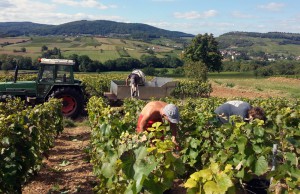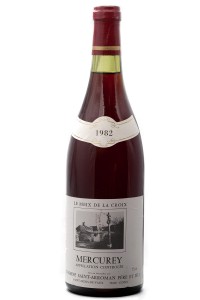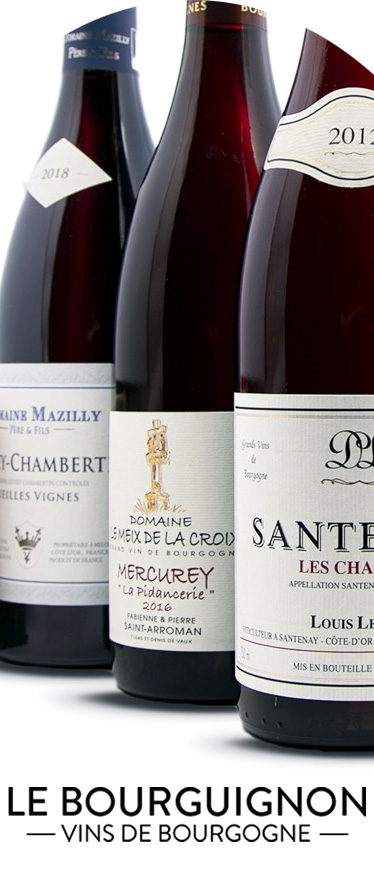Mercurey is one of the largest appellations in Burgundy and the largest of the three Côtes: Nuits, Beaune and Chalon

A dozen kilometers south of Chagny in Burgundy, on the backbone of the Côte Chalonnaise, Mercurey occupies 847 hectares of vineyards.
One of the oldest French AOCs created in 1936, the AOC Mercurey is a communal appellation of Burgundy produced in two production communes: Mercurey and Saint-Martin-sous-Montaigu about ten kilometers northwest of Chalons-sur-Saône.
Mercurey and its history:
The #Bourgogne and its history in pictures: #Mercureyhttps://t.co/LAl9Zz6ivE pic.twitter.com/1NQyNq9I15
— The Passion for Wine (@LPVien) October 10, 2016
Hierarchy of appellations in Burgundy
In Burgundy, there are many appellations which is why they have been divided into 4 levels: 
- Grands Cru appellations
- Premiers cru appellations
- Communal appellations (villages)
- Regional names (sometimes called "generic" or "sub-regional")
The name Mercurey can be followed:
- self of expression: premier cru
- or the name of the original climate
- or by both for wines from parcels classified as premier cru
- itself of the only name of the climate for wines from plots not classified as premier cru
Climates classified as premier cru Commune de Mercurey:
- Clos Marcilly
- The Puillets
- The Salmonts
- The Croichots
- The Cailloute
- The Combins
- The Martin Fields
- The Clos des Barraults
- Clos des Myglands
- Le Clos l'Evêque
- The Clos Voyen
- Grand Clos Fortoul
- Clos des Grands Voyens
- The Naugues
- The Crêts
- Clos Tonnerre
- The Vasées
- The Byots
- Sazenay
- The Bondue
- La Levrière
- The Mission
- The Clos du Roy
- Griffères
- The Velley
- Clos Château de Montaigu
Some vineyards such as Clos du Roy, Clos Voyen, Champs Martin, Clos des Barraults and Clos l'Evêque have an excellent reputation.
Commune of Saint-Martin-sous-Montaigu:
- The Montaigus
- Clos des Montaigus
- The Stoves
- The Chassière
- The Alleys
- Clos de Paradis
A Mercurey from a good producer can offer excellent value for money for Burgundy wines. A large part of the winegrowers produce red wine (Pinot Noir grape variety) but you can also find some white wines (Chardonnay grape variety), or 10% of the vineyard.
Do not hesitate to take a trip to Mercurey during Saint Vincent, wine festival in Burgundy (it takes place at the end of each month of January). During this event, winemakers offer to taste their wines, so do not hesitate to take a tour!
Banners from more than 90 #Bourgogne wine appellations in the spotlight at #Mercurey for #SaintVincent2017 #SaoneEtLoire pic.twitter.com/92hwqs3LV0
— Arnaud Danjean (@ArnaudDanjean) January 28, 2017
Soil
The vineyards of the Mercurey appellation are located between 230 meters and 320 meters above sea level with a beautiful exposure varying from east to south.
There are three main sets of soils:
- To the east, on the opposite side of the valley, the soil is composed of limestone and marl.
- To the west, a sandy soil covered by Triassic sandstone and a subsoil dominated by clay-limestone in other words marl.
- To the south, there are pebbles, clay of the lias and sand.
 Discover all the Mercurey for sale on the online store.
Discover all the Mercurey for sale on the online store.
Tasting
The Mercurey en blanc appellation is very rare, composed of the Chardonnay grape variety. These wines have a lot of fruit (citrus fruits for example), notes of hazelnut, sap, slight minerality and floral aromas. On the palate a warm, opulent, pleasant wine. Drink between 10 and 12 ° C, with a potential for aging between 3 to 6 years.
This white Mercurey harmonizes perfectly with appetizers, crustaceans, white meats such as sweetbreads or pressed cheeses.
The Mercurey appellation mainly produces red wines, made from the Pinot Noir grape variety. A very beautiful red dress, concentrated and deep. A bouquet all in finesse with aromas of black fruits (cherry, blackcurrant, strawberry, …), in the mouth a beautiful tannic structure, with body,chew, crunchy fruits. This makes it a very beautiful wine for keeping between 4 to 8 years, it evolves towards spicy aromas (pepper,…), animal (leather,…).
This wine goes wonderfully well with a bean andouille, a terrine, meat (a steak, a roast pork, a piece of braised beef, a simmered poultry, a veal with carrots) and why not a Cîteaux cheese. It is advisable to serve it between 14 and 16 ° C.
"Do you know what a caress is? Drink a glass of Mercurey !"
as Colette says

